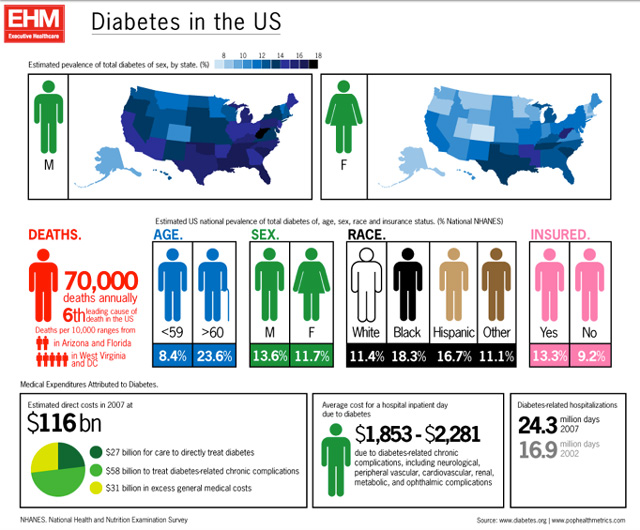Day to Day With Diabetes
By Avi Idhe
Diabetes mellitus affects 25.8 million Americans, according to the American Diabetes Association. Diabetes is a chronic, lifelong disease where there are high levels of sugar in the blood. The pancreas normally produces a hormone, insulin, to control blood sugar. In Type 1 diabetes, the body does not produce insulin. In Type 2 diabetes, the most common form, either the body does not produce enough insulin or the cells ignore the insulin. Diabetes can be caused by too little insulin, resistance to insulin, or both. Long-term complications associated with the disease include amputations secondary to vascular problems, retinopathy, and renal disease. Ultimately untreated, high blood-sugar levels can lead to coma, shock, and death. Of those 25.8 million Americans with diabetes, 12.6% of those diagnosed are African Americans.
Denise Thomas, an African American and native of the Bronx, has lived with Type 1 diabetes for over 20 years. A mother of four, Denise was first diagnosed after the birth of her youngest child. She has been insulin dependent for 13 years. This means she is required to take injections of prescribed insulin certain times of the day, because oral medications no longer work to maintain her blood sugar within a normal range. She has learned how to manage her disease over the years through instruction provided by her doctors and nurses.
According to Denise, diabetes has had a tremendous impact on her and her family’s lives. She has lost her mother as a result of the disease. Her oldest son also has the diabetes. Denise has suffered many complications as a result of her illness. “Diabetes has had a huge effect on my life, I’m now legally disabled,” she says. “I had a heart transplant in 2006, and two of my big toes amputated on each foot because of poor blood circulation. My vision is not as accurate as it once was. Due to the heart surgery, my immune system is extremely low, so I get sick very easily. I’m constantly in and out of the hospital about every four months.”
Denise describes a typical day living with diabetes. Some days she has energy to do house chores such as cooking and cleaning. Other days she is in too much pain, and rests all day, relying on prescription medication. Denise identifies stress as a major contributor to her high blood-sugar levels. She says she does several things to help alleviate her stress. In addition to taking medication, she reads, exercises, and spends time with her family.
According to Nancy DeLauro, a public health nurse in upstate New York, diabetes can be managed successfully. “Meeting the needs of a diabetic patient is best accomplished through a team approach,” she says. She recommends the patient meet with a nutritionist and a nurse educator to learn more about diet and exercise.
As part of her treatment, Denise checks her blood sugar with a glucometer twice a day. She prepares and administers her insulin injection. She then has breakfast that typically follows a diabetic diet. In the evening she repeats the blood-sugar test and then has an evening meal. During the day, if she can tolerate exercise and is not short of breath, she may spend a few minutes on a stationary bike.
Mel Thomas, Denise’s youngest son, has witnessed the impact diabetes has had on his mother and his immediate family firsthand. Observing the struggle his mother goes through has motivated him to become more health conscious. He tries to work out and eat healthier, but believes he can improve in these areas. Mel is aware of the familial predisposition to the disease, and does worry about developing diabetes later in life. He says he “tries not to focus on the negative,” and instead does the things he can do to live healthier.
In the meanwhile, he helps his mother with simple exercise, does house chores and grocery shopping. “Diabetes is a huge problem, especially in the black community,” he says. He blames lack of education and the easy availability of fast food.
According to the American Diabetes Association, diabetes can be prevented, or the onset of Type 2 diabetes can be delayed through a healthy lifestyle. The ADA recommends healthy dietary changes, increase in the level of physical activity, and maintaining a healthy weight.
Denise continues to keep a positive attitude, even through the many challenges she faces as a result of diabetes. She continues to take her medication, and regularly consults with her doctor. Denise often regrets not taking better care of herself prior to becoming insulin dependent. “There’s not one day that goes by that I don’t regret not taking better care of my health when I had the chance to. I pray to GOD every day he continues to give me the strength I need to live and see another day.”

